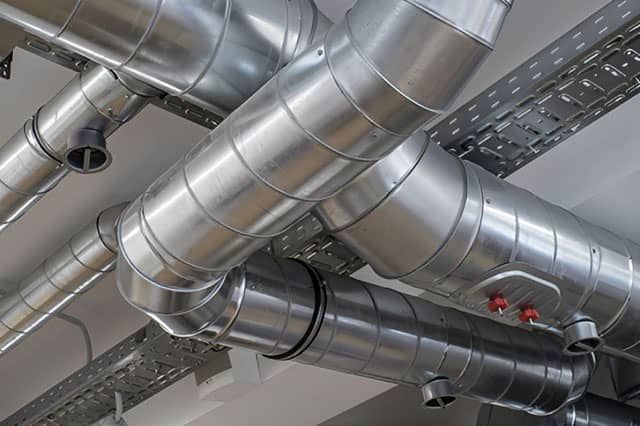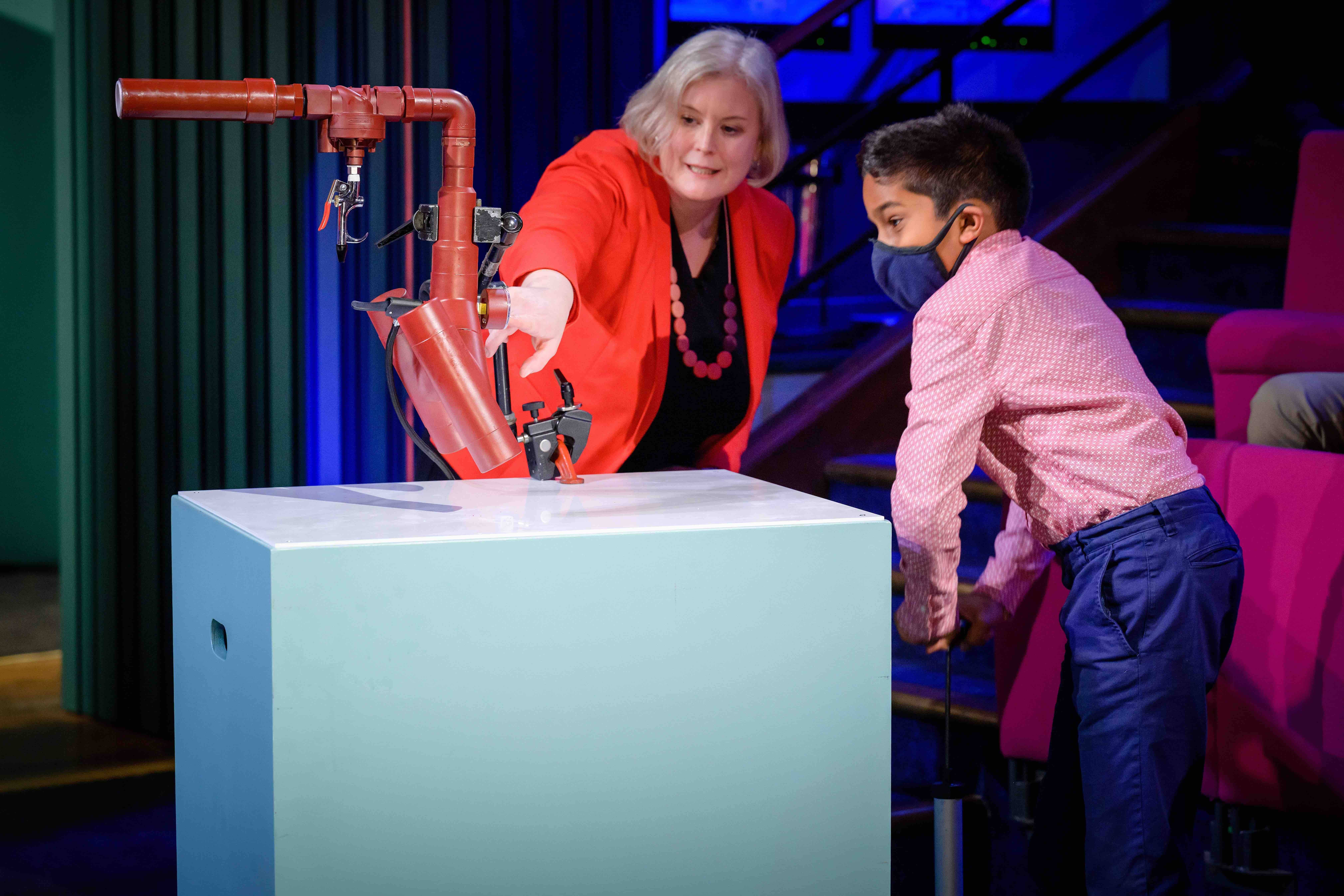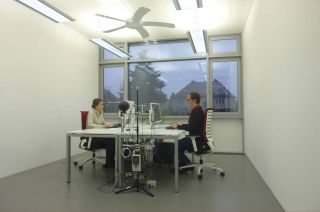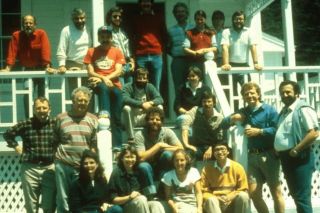Ventilation and Infection in Buildings

RESEARCH PATHWAY: personal reflections on a career in research
Engineer Cath Noakes (University of Leeds) reflects on motivations that led to a career researching building ventilation and airborne infection. She considers how the pandemic has exposed weaknesses in our built environment that will influence future research, policy and practice.
The way we design and operate buildings has a significant impact on health, including the transmission of infectious diseases. It seems obvious to say this after more than three years of a pandemic, and yet the relationships between buildings and health are hugely under-explored. Until the pandemic I was one of a small number of researchers worldwide who focused on managing transmission of infection in buildings. My research was often regarded as niche and of minor interest compared to the ‘bigger’ topics of energy performance and sustainability, and I landed in this field due to opportunities and choices that I never expected.
Go with the flow
As an undergraduate at Leeds University, I studied mechanical engineering and discovered fluid dynamics – it fascinated me that the beautiful and powerful structures in nature could be modelled using the same set of equations, that could also be used to optimise industrial processes, understand blood flow in the human body and design car engines. A PhD in modelling the thin film coating processes used to make photographic film followed by a research post in collaboration with industry designing industrial dryers developed my expertise in computational fluid dynamics (CFD) and seemed to be setting me on a track to a career in process industry R&D. But whilst I was job hunting in 2002, a new opportunity as a postdoctoral researcher in civil engineering at Leeds University working with Clive Beggs came along – a role on a project modelling ultraviolet (UV) air disinfection devices to control tuberculosis (TB).
At this point I knew nothing about buildings, ventilation, microbiology or infection. I enjoyed research but wasn’t particularly interested in an academic career route. But the project intrigued me and appealed to my sense of curiosity - I realised that I could apply my fluid dynamics knowledge to this interesting and very different challenge. I started working on buildings and health at a time when there was concern around the rise in drug resistant TB, a growing focus on hospital acquired infections e.g. methicillin-resistantStaphylococcus aureus (MRSA) and C difficile – this was just before the SARs outbreak in 2003. With SARs, airborne infection was suddenly an important question for policy makers, and there was an interest in understanding more around engineering approaches to mitigate risks. Through coupling CFD models of indoor air flows with 3D models of UV light and experimental data on microorganism susceptibility to UV we developed the first models (Noakes et al. 2004) to show how the performance of upper-room UV devices varies with ventilation, geometry and pathogen.
Changing fields as a researcher is challenging and has a steep learning curve, but it turned out to be the best move I ever made and I have never looked back. Working on buildings and health is inherently interdisciplinary, involving building sciences, mathematical modelling, microbiology, clinical expertise and increasingly behavioural sciences. I quickly realised how much I enjoyed working on challenges that had a clear societal benefit and needed collaboration with people across a range of different areas to be successful. My time as a postdoctoral researcher built my knowledge of ventilation and the built environment and also gave me experience of teaching the principles of building physics, services design and indoor air quality alongside tackling specific research questions around airborne infection. I was able to connect with international projects working on related areas - Ed Nardell at Harvard University who was also carrying out measurements of UV effectiveness and a high profile project in Peru led by Rod Escombe which measured human to guinea pig transmission in a TB ward (Escombe et al. 2009). Both of these connections gave me an insight into the international challenges around airborne infection as well as working directly on clinically applied research. I still collaborate with both Ed and Rod today.
Learning to lead
All the ‘rule books’ say you should move institutions to build an academic career but it turns out this wasn’t true for me. I joined Leeds as an undergraduate and have been there ever since. There is also never a good time for anything. Taking on a lectureship with a 15-month-old child was hard work, but understanding colleagues and family support have allowed me to make it work.
A major shift as a lecturer was the sudden realisation that I was now in charge. I was no longer following the path of a project that someone else had conceived, and I suddenly had to learn about funding applications, financial management, human resources and the nuances of managing people and projects. A huge amount is learning by doing and figuring out the best way to pitch for a project and hope that you have resourced it correctly. Within this there is determination, collaboration and quite a bit of luck. I know that have been lucky and had some good success securing research funding.
Perhaps less obvious is the ‘CV of failures’. For every grant I’ve won, I would guess that there are at least three that have not succeeded and this part of academia doesn’t get talked about often enough. Even now, it hits hard when your best ideas don’t reach high enough in the ranking to secure funding. The ‘luck of the draw’ while competing for limited funds across multiple different disciplines plays a big part. However, working in a cross-disciplinary space can make it harder, as proposals often have to satisfy reviewers from all of the relevant fields that the work is novel and important. Looking back, I wonder what could have been - for example an unfunded proposal in 2010 to provide cross-discipline training to PhD students in engineering control of environmental hazards would have been relevant to a pandemic.
I was fortunate to secure a five year ‘Challenging Engineering’ award from the UK Engineering and Physical Sciences Research Council in 2008 which gave me flexible fellowship funding to explore hospital ventilation and infection risks. This was a real boost and supported several postdoctoral and PhD researchers – all are now successful in their own right including three who are in academic roles. This project also opened up significant routes to new collaborations. Working with Alan Short and Andy Woods at Cambridge University we carried out substantial work around natural ventilation of hospitals bringing together measurements (Gilkeson et al. 2013) to characterise flow conditions alongside computational modelling (Short et al. 2014). It was clear from this work that original Nightingale ward designs could have very good ventilation and be thermally comfortable. However, changes for energy efficiency over the years (e.g. replacement windows, blocked up vents and false ceilings) compromised both the ventilation flows and thermal comfort. Another strand of work modelled relationships between microorganisms in air and deposition onto surfaces (King et al. 2015), showing ward layout and ventilation impacted on the risk of infection through hand contact as well as direct airborne infection. This set off a new research path led by my colleague Marco-Felipe King with collaborators in the US and Hong Kong on quantitative microbial risk assessment applied to healthcare infections.
And then came Covid-19…
In early March 2020 I stepped down after six years of Director of Research and Innovation in my School and for the first time in a long while was looking forward to some breathing space for new research ideas. How wrong I was. In early April I received an email out of the blue from the secretariat of the UK Scientific Advisory Committee for Emergencies (SAGE) asking whether I would put together a paper on the environmental aspects of transmission of the SARS-CoV-2 virus. This was very early days in pandemic research, with only a very small number of pre-prints that considered transmission modes, so most of this had to draw on past work around influenza and SARs as well as fundamental experimental and modelling studies.
Looking back now, given all that we have learned, I’m proud that around
90% of what was in that first paper (SAGE EMG 2020)
remained correct. By mid-April I was co-chair of a new SAGE sub-group, focusing
on transmission - the environment and modelling group (EMG). The EMG was
created in just one week, and another week later we had delivered our next
commissioned paper. The group brought together a diverse cross disciplinary
group from academia and the public sector - mathematical modellers, engineers,
architects, microbiologists, clinicians, public health expertise, behavioural
science and more. Although this new group could have experienced challenges
around interdisciplinary working, the common and urgent goal of mitigating a
pandemic together with a culture of ‘there are no stupid questions’ meant that
we rapidly built effective working relationships. Members of the group all
brought different perspectives and experiences which were a huge asset in
ensuring that we considered problems in the widest way possible and reduced
biases based on our preconceived assumptions. Over the next 18 months we delivered over 50
papers and supported national guidance and public messaging. The vast set of
questions posed by the pandemic also sparked a huge research effort and I was
privileged to be in a leadership role in several very large projects including
leading a theme within the PROTECT National Core Study (n.d.) which brought together over 200 researchers
from over 20 institutions. 
My experience during the pandemic was quite extraordinary and it was an enormous privilege to contribute to something so significant. It was also a position of huge responsibility - suddenly my research and expertise, and that of my colleagues and collaborators, was supporting life and death decisions. We all have opinions and theories that something could be important, but when your words could change policy on a national scale, then an intuition is not enough. It was essential to provide policy makers and the public evidenced based understanding of transmission and how it could be mitigated. This included bringing to the fore the science that underpinned the contribution and complexity of airborne transmission and the importance of the built environment. This was an enormous team effort and I have worked with hundreds of people in the UK and internationally to carry out new research, bring together evidence in as quick and unbiased a way as possible and to share the understanding in clear and concise language. At times this has included rebutting challenges to the scientific evidence and also explaining why new evidence means our understanding has changed.
A new outlook
So where does this leave things now? The pandemic has raised awareness of the importance of the built environment for health and it is critical that this focus is not lost, especially with the current cost of energy. At the outset, there were a small number of people actively working on buildings and health, and although that has grown, there remains a lack of research capacity in this area. There is still a need for fundamental studies on the mechanisms of infection transmission and the role of the built environment, but more than ever they need to bring together cross-discipline expertise particularly involving health, microbiology and behavioural science expertise alongside building sciences and engineering to ensure that research properly contributes to new knowledge and that studies are robust and reliable.
The pandemic has exposed big gaps in real world application and practice as set out by the Royal Academy of Engineering work on Infection Resilient Environments (NEPC 2022). I was regularly asked ‘how many buildings are poorly ventilated?’ and we simply don’t have sufficient data to properly answer that question and to understand how and why that varies across the vast number of different building types and sectors. Academic funding tends to reward novel science, yet many of the gaps in our knowledge are less about novel technologies and more about the complexity of application, and the interface of technology with user behaviour. It is crucial that these types of studies are funded and collated together to build the evidence base for what really works in practice.
The past three years have also demonstrated the importance of researchers engaging with policy makers, practitioners and the public. Real change happens when regulators require evidence and advice, public opinion shifts or industry can commercialise it. It is critical that research into healthy built environments is championed effectively so that the evidence can be properly brought to bear on real world challenges. Public engagement with science is a huge part of this process. Prior to the pandemic I had shied away from engaging with the media and my presence on Twitter was limited to interactions with a close circle in my own field. However, I rapidly realised that it was important to explain complex topics like natural ventilation to the public as part of developing a wider understanding about the variability that we experience in buildings. I would encourage all researchers at any career stage to get involved with policy or public engagement activities – whatever your study, the understanding of how problems are perceived and the approaches that are taken to translate research into impact will improve the research that you do.
We have taken some huge leaps in the past three years – I never thought I would see national political leaders encouraging people to ventilate their buildings. But it seems that it is too easy to forget. I truly hope that civil society and our leaders will learn the lessons of a pandemic and put this alongside the growing awareness of the health effects of indoor air quality to properly position health alongside sustainability and safety in future education, research and development of our buildings and city infrastructure.
References
Escombe A.R., Moore D.A.J., Gilman R.H., Navincopa M., Ticona E., Mitchell B., Noakes C.J., Martínez C., Sheen P., Ramirez R., Quino W., Gonzalez A., Friedland J.S., Evans C.A. (2009). Upper-room ultraviolet light and negative air ionization to prevent tuberculosis transmission. PLOS medicine 6(3), e1000043. https://doi.org/10.1371/journal.pmed.1000043
Gilkeson C.A., Camargo-Valero M.A., Pickin L.E., Noakes C.J. (2013). Measurement of ventilation and airborne infection risk in large naturally ventilated hospital wards. Building and Environment, 65:35-48. https://doi.org/10.1016/j.buildenv.2013.03.006
King M.F., Noakes C.J. & Sleigh P.A. (2015). Modelling environmental contamination in hospital single and four-bed rooms. Indoor Air, 25(6): 694-707. https://doi.org/10.1111/ina.12186
National Engineering Policy Centre (NEPC). (2022). Infection Resilient Environments. https://nepc.raeng.org.uk/infection-resilient-environments
Noakes C.J., Beggs C.B. & Sleigh, P.A. (2004). Modelling the performance of upper room ultraviolet germicidal irradiation devices in ventilated rooms: comparison of analytical and CFD methods. Indoor and Built Environment, 13(6), 477-488. https://eprints.whiterose.ac.uk/77737/
The PROTECT COVID-19 National Core Study on transmission and environment (n.d.). https://sites.manchester.ac.uk/covid19-national-project/
Scientific Advisory Group for Emergencies (SAGE) Environmental Monitoring Group (EMG). (2020, 14 April). Evidence of environmental dispersion of COVID-19 for different mechanisms. https://www.gov.uk/government/publications/evidence-of-environmental-dispersion-of-covid-19-for-different-mechanisms-14-april-2020
Short C.A., Noakes C.J., Gilkeson C.A. & Fair A. (2014). Functional recovery of a resilient hospital type. Building Research & Information, 42, 657-684. https://doi.org/10.1080/09613218.2014.926605
Share:
Latest Peer-Reviewed Journal Content
Evaluating mitigation strategies for building stocks against absolute climate targets
L Hvid Horup, P K Ohms, M Hauschild, S R B Gummidi, A Q Secher, C Thuesen, M Ryberg
Equity and justice in urban coastal adaptation planning: new evaluation framework
T Okamoto & A Doyon
Normative future visioning: a critical pedagogy for transformative adaptation
T Comelli, M Pelling, M Hope, J Ensor, M E Filippi, E Y Menteşe & J McCloskey
Suburban climate adaptation governance: assumptions and imaginaries affecting peripheral municipalities
L Cerrada Morato
Urban shrinkage as a catalyst for transformative adaptation
L Mabon, M Sato & N Mabon
Maintaining a city against nature: climate adaptation in Beira
J Schubert
Ventilation regulations and occupant practices: undetectable pollution and invisible extraction
J Few, M Shipworth & C Elwell
Nature for resilience reconfigured: global- to-local translation of frames in Africa
K Rochell, H Bulkeley & H Runhaar
How hegemonic discourses of sustainability influence urban climate action
V Castán Broto, L Westman & P Huang
Fabric first: is it still the right approach?
N Eyre, T Fawcett, M Topouzi, G Killip, T Oreszczyn, K Jenkinson & J Rosenow
Gender and the heat pump transition
J Crawley, F Wade & M de Wilde
Social value of the built environment [editorial]
F Samuel & K Watson
Understanding demolition [editorial]
S Huuhka
Data politics in the built environment [editorial]
A Karvonen & T Hargreaves
European building passports: developments, challenges and future roles
M Buchholz & T Lützkendorf
Decision-support for selecting demolition waste management strategies
M van den Berg, L Hulsbeek & H Voordijk
Assessing social value in housing design: contributions of the capability approach
J-C Dissart & L Ricaurte
Electricity consumption in commercial buildings during Covid-19
G P Duggan, P Bauleo, M Authier, P A Aloise-Young, J Care & D Zimmerle
Disruptive data: historicising the platformisation of Dublin’s taxi industry
J White & S Larsson
Impact of 2050 tree shading strategies on building cooling demands
A Czekajlo, J Alva, J Szeto, C Girling & R Kellett
Social values and social infrastructures: a multi-perspective approach to place
A Legeby & C Pech
Resilience of racialized segregation is an ecological factor: Baltimore case study
S T A Pickett, J M Grove, C G Boone & G L Buckley



Latest Commentaries
Time to Question Demolition!
André Thomsen (Delft University of Technology) comments on the recent Buildings & Cities special issue ‘Understanding Demolition’ and explains why this phenomenon is only beginning to be understood more fully as a social and behavioural set of issues. Do we need an epidemiology of different demolition rates?
Where are Women of Colour in Urban Planning?
Safaa Charafi asks: is it possible to decolonialise the planning profession to create more inclusive and egalitarian urban settings? It is widely accepted that cities are built by men for other men. This male domination in urban planning results in cities that often do not adequately address challenges encountered by women or ethnic and social minorities. Although efforts are being taken to include women in urban planning, women of colour are still under-represented in many countries, resulting in cities that often overlook their needs.